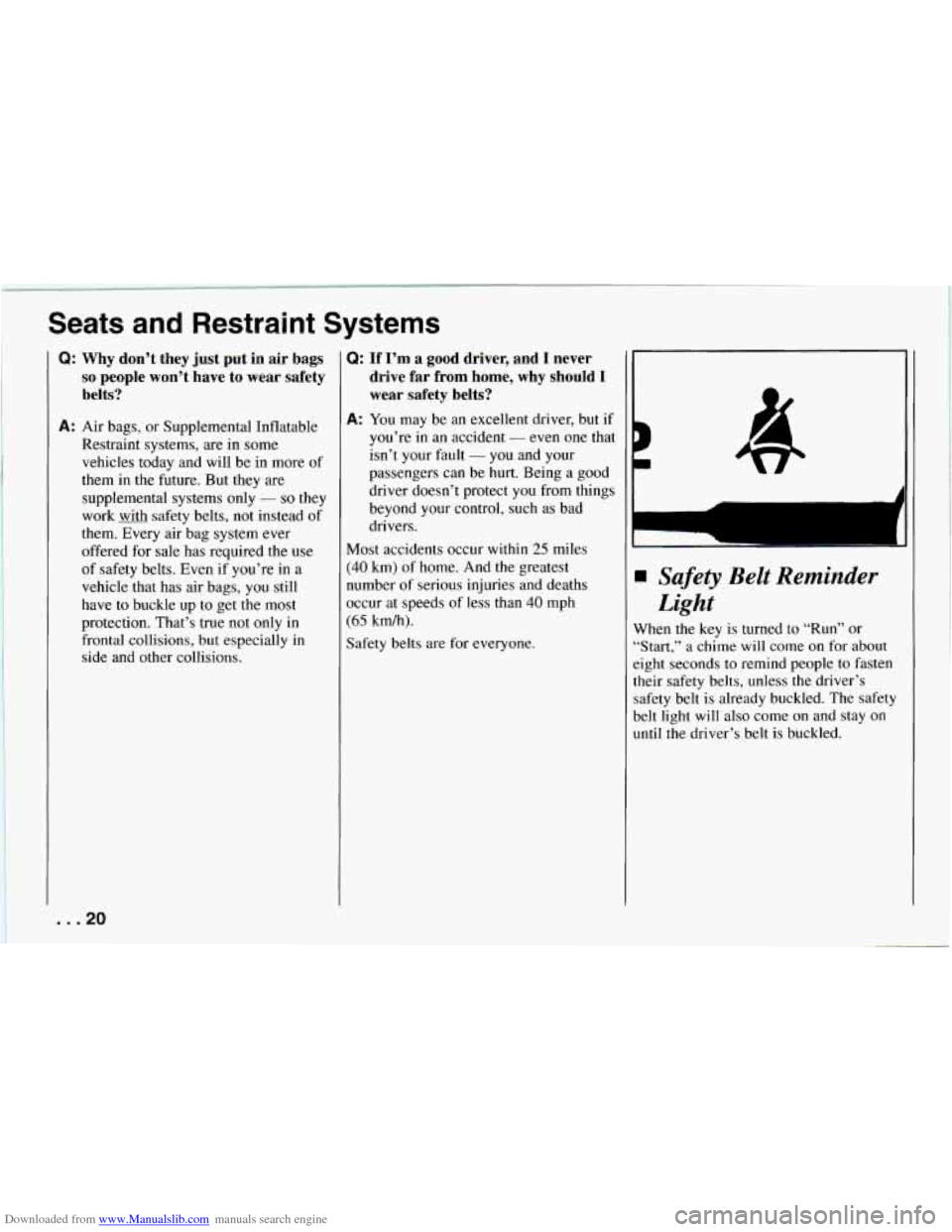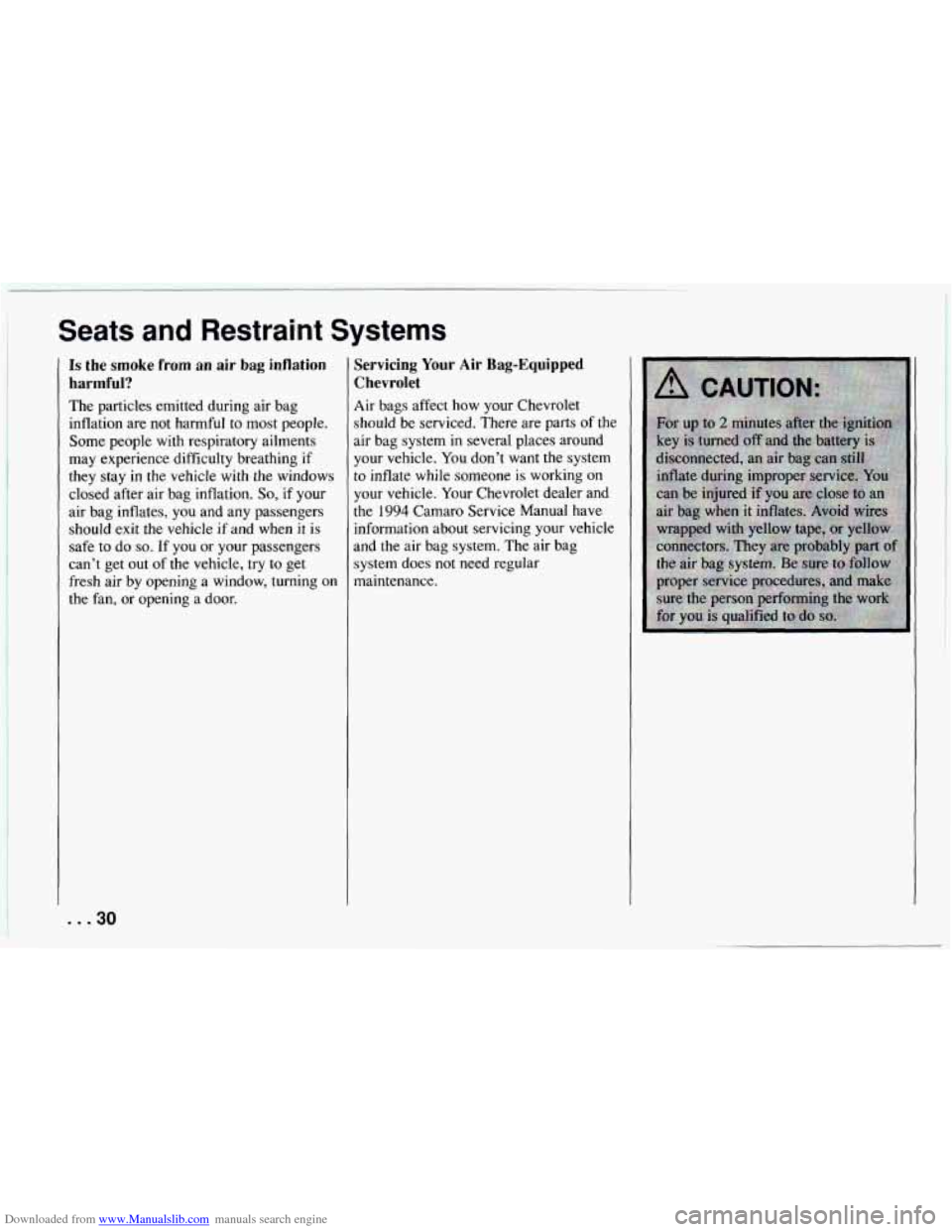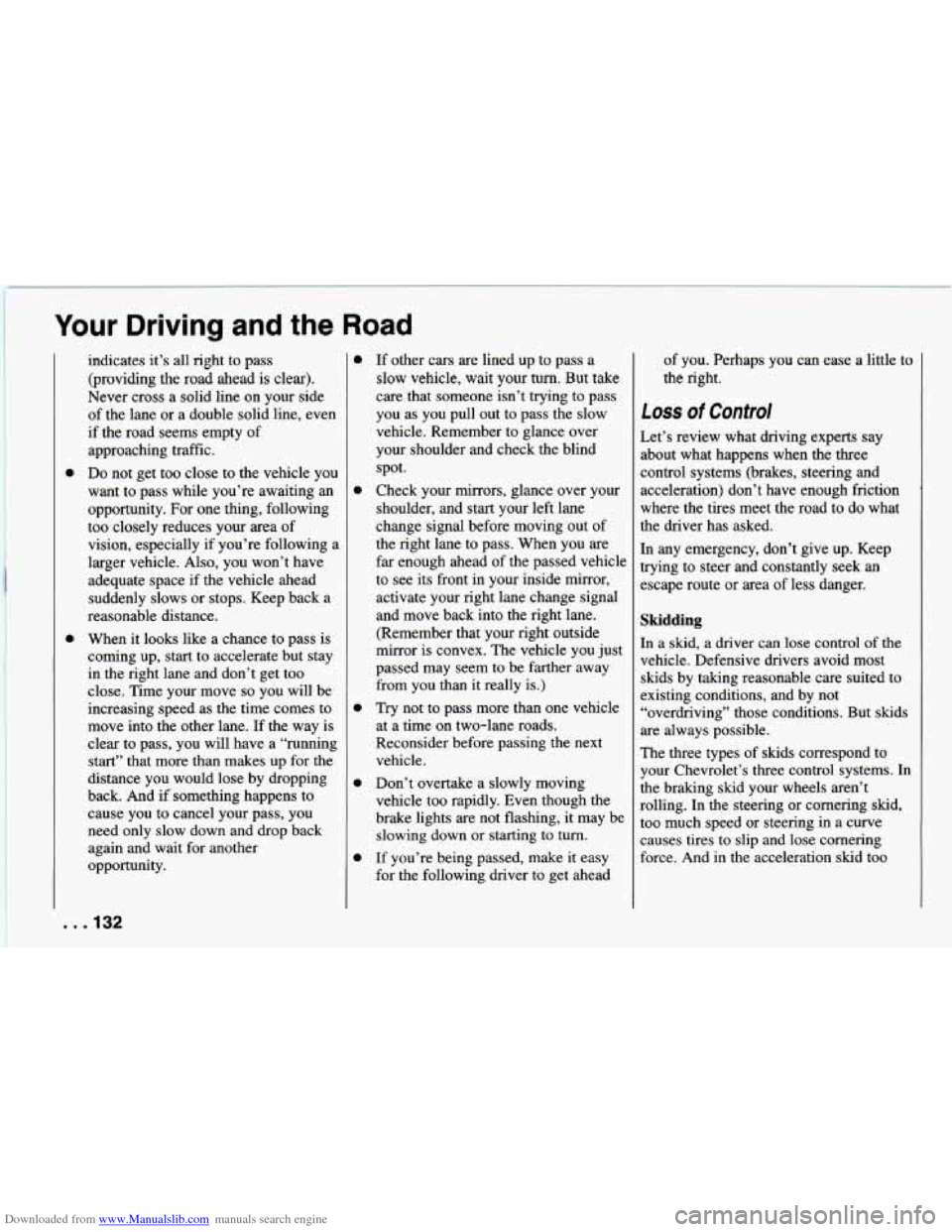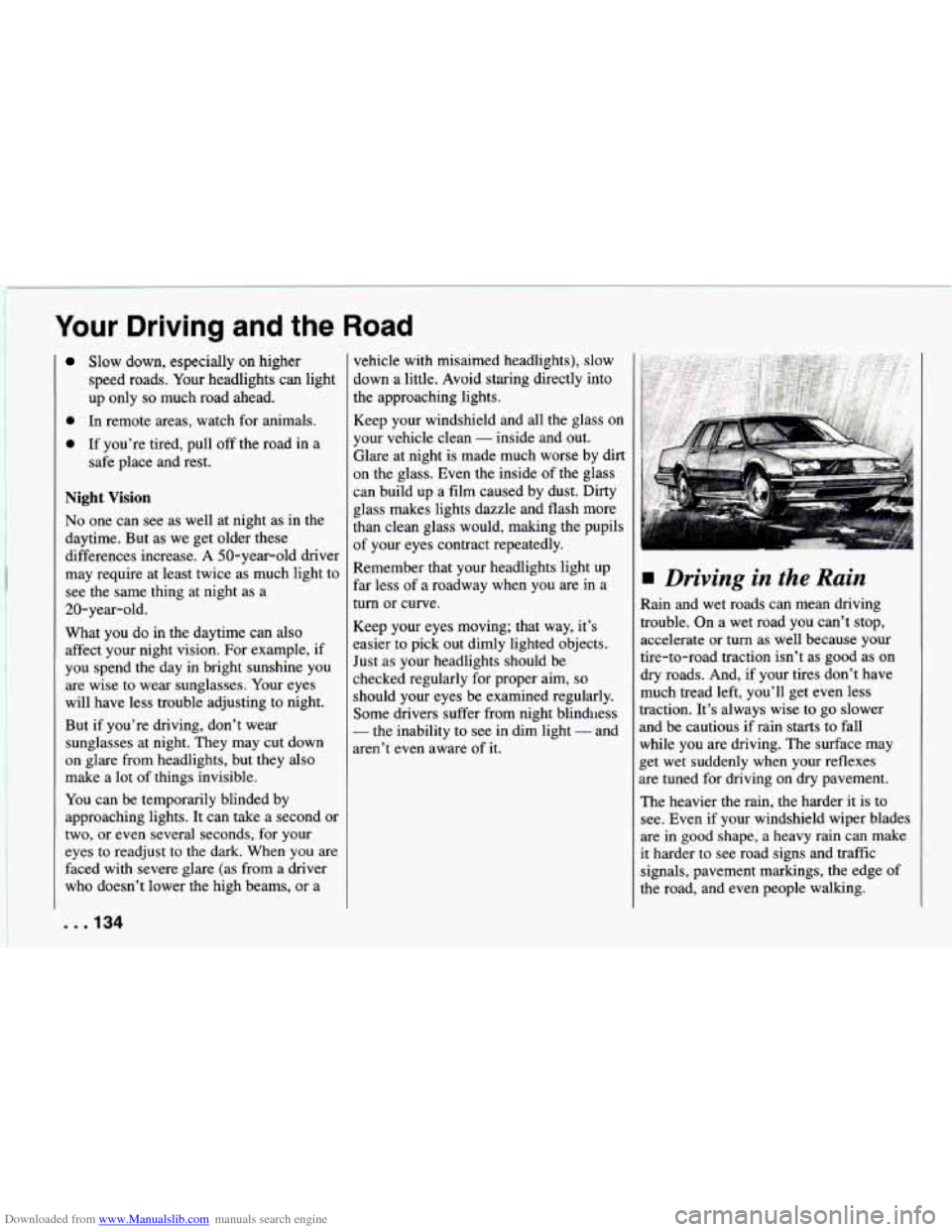ESP CHEVROLET CAMARO 1994 4.G Owners Manual
[x] Cancel search | Manufacturer: CHEVROLET, Model Year: 1994, Model line: CAMARO, Model: CHEVROLET CAMARO 1994 4.GPages: 292, PDF Size: 15.35 MB
Page 22 of 292

Downloaded from www.Manualslib.com manuals search engine Seats and Restraint Systems
Q: Why don’t they just put in air bags
so people won’t have to wear safety
belts?
A: Air bags, or Supplemental Inflatable
Restraint systems, are in some
vehicles today and will be in more of
them in the future. But they are
supplemental systems only
- so they
work
with safety belts, not instead of
them. Every air bag system ever
offered for sale has required the use
of safety belts. Even if you’re in
a
vehicle that has air bags, you still
have to buckle up
to get the most
protection. That’s true not only
in
frontal collisions, but especially in
side and other collisions.
Q: If I’m a good driver, and 1 never
drive far from home, why should
I
wear safety belts?
A: You may be an excellent driver, but if
you’re in an accident - even one that
isn’t your fault
- you and your
passengers can be hurt. Being
a good
driver doesn’t protect you from things
beyond your control, such as bad
drivers.
Most accidents occur within
25 miles
(40 km) of home. And the greatest
number
of serious injuries and deaths
occur at speeds
of less than 40 mph
(65 km/h).
Safety belts are for everyone.
Safety Belt Reminder
Light
When the key is turned to “Run” or
“Start,” a chime
will come on for about
eight seconds to remind people
to fasten
their safety belts, unless
the driver’s
safety belt is already buckled. The safety
belt light will also come
on and stay on
until the driver’s belt is buckled.
... 20
Page 32 of 292

Downloaded from www.Manualslib.com manuals search engine Seats and Restraint Systems
Is the smoke from an air bag inflation
harmful?
The particles emitted during air bag
inflation are not harmful to most people.
Some people with respiratory ailments
may experience difficulty breathing if
they stay in the vehicle with the windows
closed after air bag inflation.
So, if your
air bag inflates, you
and any passengers
should exit the vehicle if and when it is
safe to do
so. If you or your passengers
can’t get out
of the vehicle, try to get
fresh air by opening
a window, turning on
the fan, or opening a door.
Servicing Your Air Bag-Equipped
Chevrolet
Air bags affect how your Chevrolet
should be serviced. There are parts of the
air bag system in several places around
your vehicle. You don’t want the system
to inflate while someone is working on
your vehicle. Your Chevrolet dealer and
the
1994 Camaro Service Manual have
information about servicing your vehicle
and the air bag system. The air bag
system does not need regular
maintenance.
... 30
Page 55 of 292

Downloaded from www.Manualslib.com manuals search engine Theft
Vehicle theft is big business, especially in
some cities. Although your Chevrolet has
a number of theft-deterrent features, we
know that nothing we put on it can make
it impossible to steal. However, there
are
ways you can help.
Key in the ignition: If you walk away
from your vehicle with the keys inside,
it’s an easy target for joy riders or
professional thieves
- so don’t do it.
When you park your Chevrolet and open
the driver’s door, you’ll hear a tone
reminding you to remove your key from
the ignition and take it with
you. Always
do this. Your steering wheel will be
locked, and
so will your ignition. If you
have an automatic transmission, taking
your key out also locks your transmission.
And remember
to lock the doors.
Parking at Night: Park in a lighted spot,
close all windows and lock your vehicle.
Remember
to keep your valuables out of
sight. Put them in a storage area, or take
them with you.
Parking Lots: If you park in a lot where
Someone will be watching your vehicle,
it’s best to lock it up and take your keys.
But what if you have to leave your
ignition key? What if you have to leave
something valuable in your vehicle?
0 Put your valuables in a storage area,
like your glove box.
0 Lock the glove box.
0 Lock all the doors except the driver’s.
Then take the door key with you.
PASS-Key@ZZ
Your vehicle is equipped with the
PASS-Key@II (Personalized Automotive
Security System) theft-deterrent system.
PASS-Key@II is a passive theft-deterrent
system. This means you don’t have
to do
anything different to arm or disarm the
system. It works when you insert
or
remove the key from the ignition.
PASS-Key@II uses a resistor pellet in
the ignition key that matches a decoder
in your vehicle.
53.
Page 81 of 292

Downloaded from www.Manualslib.com manuals search engine To Get Out of Cruise Control
There are several ways to turn off the
Cruise Control:
1. Step lightly on the brake pedal or push
the clutch pedal, if you have a manual
transmission;
2. Move the Cruise switch to “OFF.”
To Erase Speed Memory
When you turn off the Cruise Control or
the ignition, your Cruise Control set speel
memory is erased.
ASR and Cruise Control
If your ASR system engages while your
Cruise Control is set, Cruise Control will
disengage. Your speed will be set in
memory, though. When Cruise Control
engages again, use “WAY’
(Resume/Accelerate) to
go back to your
set speed.
Operation of Lights
4lthough your vehicle’s lighting system
:headlights, parking lights, fog lamps,
side marker lights and taillights) meets all
ipplicable federal lighting requirements,
Zertain states and provinces may apply
:heir own lighting regulations that may
require special attention before you
>perate these lights.
For example, some jurisdictions may
require that you operate fog lamps only
when your lower beam headlights are also
m, or that headlights be turned on
whenever you must use your windshield
wipers. In addition, most jurisdictions
prohibit driving solely with parkmg
lights, especially at dawn or dusk. It is
recommended that you check with your
own state or provincial highway authority
for applicable lighting regulations.
/Y...
Page 122 of 292

Downloaded from www.Manualslib.com manuals search engine Comfort Controls and Audio Systems
6. Turn the lower knob until the fifth and
sixth digits
of your code appear,
7. Press the lower knob. The clock
display will appear and the unit will
work. If
“LOC” shows, the numbers
did not match and the unit is still
locked.
How to Change Your Security Code
You can change your security code by
following these steps:
1. Using your old code, follow the
directions given under “Shutting
Off
the Theft-Deterrent Feature.”
2. Repeat directions of “Setting Your
Security Code” with your new
security code.
Understanding Radio Reception
FM Stereo
FM stereo will give you the best sound.
But
FM signals will reach only about
10 to 40 miles (16 to 65 km). And, tall
buildings or hills can interfere with
FM signals, causing the sound to come
and go.
I
AM
The range for most AM stations is greater
than for
FM, especially at night. The
longer range, however, can cause stations
to interfere with each other. AM can pick
up noise from things like storms and
power lines. Try reducing the treble to
reduce this noise if you ever get it.
AM Stereo
This means the Delco@ system can
receive C-QUAM@ stereo broadcasts.
Many
AM stations around the country use
C-QUAM@ to produce stereo, though
some do not. (C-QUAM@
is a registered
trademark of Motorola, Inc.) If your
Delco@ system can get C-QUAM@, your
“STEREO” light will come on when
you’re receiving it.
Care of Your Cassette Tape
Player
A tape player that is not cleaned regularly
can cause reduced sound quality, ruined
cassettes, or a damaged mechanism.
Cassette tapes should be stored in their
cases away from contaminants, direct
sunlight, and extreme heat. If they aren’t,
they may not operate properly or cause
failure of the tape player.
Your tape player should
be cleaned
regularly each month or after every
15
hours of use. If you notice a reduction in
sound quality, try a known good cassette
to see if the tape or the tape player
is at
fault. If this other cassette has no
. . .I20
Page 128 of 292

Downloaded from www.Manualslib.com manuals search engine Your Driving and the Road
There’s something else about drinlcing
md driving that many people don’t know.
Medical research shows that alcohol in a
person’s system can make crash injuries
worse. That’s especially true for brain,
spinal card and heart injuries. That means
that if anyone who has been drinking -
driver or passenger - is in a crash, the
chance of being killed or penmmently
disabled is higher than
if that person had
not been &inking. And we’ve already
seen that the chance of a crash itself is
higher far drinkine drivers.
itn~ have three systems that make you
rehide go where you want it to go. They
ue the brakes, the steering and the
um&mtor.
All thee systems have to do
heir work at the places where the tires
neet the road.
Zametimea;, as when you’re driving on
mow or ice, it’s easy to ask more of those
:ontrol systems than the tires and road
can provide. That means you can lose
control of your vehicle.
Br4king
hkblg WtiQIl hVlolV(eB
and reaction time.
First,
you have to decide to push on the
brake pedal. That% perception time,
Then you have to bring up yslur foot
and
do it. That’s
. . ,126
Page 130 of 292

Downloaded from www.Manualslib.com manuals search engine Your Driving and the Road
Here’s how anti-lock works. Let’s say
the road is wet. You’re driving safely. Suddenly an animal jumps out
in front
You slam on the brakes. Here’s what
happens with ABS.
A computer senses that wheels are
slowing down. If one of the wheels is
about to stop rolling, the computer will
separately work the brakes at each front
wheel and at the rear wheels.
The anti-lock system can change the
brake pressure faster than any driver
could. The computer
is programmed to
make the most of available tire and road
conditions.
of you.
You can
steer around the obstacle while
braking hard.
As you brake, your computer keeps
receiving updates on wheel speed and
controls braking pressure accordingly.
Remember: Anti-lock doesn’t change the
time
you need to get your foot up to the
brake pedal.
If you get too close to the
vehicle in front of you,
you won’t have
time to apply your brakes if that vehicle
suddenly slows or stops. Always leave
enough room up ahead to stop,
even
though you have anti-lock brakes.
To Use Anti-Lock
Don’t pump the brakes. Just hold the
brake pedal down and let anti-lock
work for you. You may feel the system
working, or you may notice some noise, but this is normal. When your anti-lock
system
is adjusting brake pressure to help
avoid a braking skid, the
“LOW TRAC”
light will come
on. See “Low Traction
Light”
in the Index.
ASR (Acceleration Slip Regulation) System (Option:
LT1 VS Engine)
Your vehicle may have an ASR system
that limits wheel spin. This
is especially
useful in slippery road conditions. The
system operates only
if it senses that one
or both of the rear wheels are spinning or
beginning
to lose traction.
When this happens, the system works the
rear brakes and reduces engine power (by closing the throttle and managing spark)
to limit wheel spin.
The “LOW TRAC” light will come on
when your
ASR system is limiting wheel
spin. See “Low Traction Light” in the
Index. You may
feel the system working,
or you may notice some noise, but this is
normal.
The
ASR system may operate on dry
roads under some conditions, and you
may notice a reduction
in acceleration
when this happens.
This is normal and
doesn’t mean there’s a problem with
your
vehicle. Examples of these conditions
include a hard acceleration
in a turn, or
an abrupt upshift or downshift.
. . .I28
Page 131 of 292

Downloaded from www.Manualslib.com manuals search engine ‘I i
If your vehicle is in cruise control when
the ASR system begins
to limit wheel
spin, the cruise control will automaticallq
disengage. When road conditions allow
you to safely use it again, you may
re-engage the cruise control. (See
“Cruise Control” in the Index.)
The “ASR” warning light will come on
when you tu-n the ASR system off. Whe~
the system is on, this light will come on
to let you know if there’s a problem with
your ASR system.
See “ASR System
Warning Light” in the Index.
When this warning light is on, the system
will not limit wheel spin. Adjust your
drjving accordingly.
ASR
The ASR system automatically comes on
whenever you start your vehicle.
To limit wheel spin, especially in
slippery road conditions, you should
always leave the system on. But you can
turn the ASR system
off if you ever need
to. (You should turn the system
off if
your vehicle ever gets stuck in sand,
mud, ice or snow.
See “Rocking Your
Vehicle” in the Index.)
To turn the system
off, press the button on
the console near the cigarette lighter. The
“ASIC” warning light will come on and
stay on. -If the ASR system is limiting
wheel spin when you press the button, the
system won’t turn off right away. It will
wait until there’s no longer a current need
to limit wheel spin. You
can turn the system back on at any
time by pressing the button again. The
*‘ASR’ warning light should go
off.
[f your car is equipped with P245/50ZR16
tires, the ASR system will automatically
turn
off at speeds above 108 mph (173
km/h). (The “ASR” warning light will
not come on.) When vehicle speed drops
below
103 mph (165 km/h), the system
will automatically turn on again.
Braking in Emergencies
Use your anti-lock braking system when
you need to. With anti-lock, you can
steer and brake
a1 the same time. In many
emergencies, steering can help you more
than even the very best braking.
129 ...
Page 134 of 292

Downloaded from www.Manualslib.com manuals search engine Your Driving and the Road
a
a
indicates it’s all right to pass
(providing the road ahead is clear).
Never cross a solid line on your side
of the lane or a double solid line, even
if the road seems empty of
approaching traffic.
Do not get too close to the vehicle you
want to pass while you’re awaiting an
opportunity. For one thing, following
too closely reduces your area of
vision, especially if you’re following a
larger vehicle. Also, you won’t have
adequate space if the vehicle ahead
suddenly slows or stops. Keep back a
reasonable distance.
When it looks like a chance to pass is
coming up, start to accelerate but stay
in the right lane and don’t get too
close. Time your move
so you will be
increasing speed as the time comes to
move into the other lane. If the way is
clear to pass, you will have a “running
start” that more than makes up for the
distance you would lose by dropping
back. And
if something happens to
cause you to cancel your pass, you
need only slow down and drop back
again and wait for another
opportunity.
0
a
a
a
If other cars are lined up to pass a
slow vehicle, wait
your turn. But take
care that someone isn’t trying to pass
you as you pull out to pass the slow
vehicle. Remember to glance over
your shoulder and check the blind
spot.
Check your mirrors, glance over your
shoulder, and start your left lane
change signal before moving out of
the right lane to pass. When you are
far enough ahead of the passed vehicle
to see its front in your inside mirror,
activate your right lane change signal
and move back into the right lane.
(Remember that your right outside
mirror is convex. The vehicle you just
passed may seem to be farther away
from you than it really is.)
Try not to pass more than one vehicle
at a time on two-lane roads.
Reconsider before passing the next
vehicle.
Don’t overtake a slowly moving
vehicle too rapidly. Even though the
brake lights are not flashing, it may be
slowing down
or starting to turn.
If you’re being passed, make it easy
for the following driver to get ahead
of you. Perhaps you can ease a little to
the right.
loss of Control
Let’s review what driving experts say
about what happens when the three
control systems (brakes, steering and
acceleration) don’t have enough friction
where the tires meet the road to do what
the driver has asked.
In any emergency, don’t give up. Keep
trying to steer and constantly seek an
escape route or area of less danger.
Skidding
In a skid, a driver can lose control of the
vehicle. Defensive drivers avoid most
skids by taking reasonable care suited to
existing conditions, and by not
“overdriving” those conditions. But skids
are always possible.
The three types of skids correspond to
your Chevrolet’s three control systems. In
the brakmg skid your wheels aren’t
rolling. In the steering or cornering skid,
too much speed or steering in a curve
causes tires to slip and lose cornering
force. And in the acceleration skid too
. . .132
Page 136 of 292

Downloaded from www.Manualslib.com manuals search engine Your Driving and the Road
Slow down, especially on higher
speed roads. Your headlights
can light
up only
so much road ahead.
0 In remote areas, watch for animals.
0 If you’re tired, pull off the road in a
safe place and rest.
Night Vision
No one can see as well at night as in the
daytime. But as we get older these
differences increase. A 50-year-old driver
may require at least twice as much light to
see the same thing at night as a
20-year-old.
What you do in the daytime can also
affect your night vision. For example, if
you spend the day in bright sunshine you
are wise to wear sunglasses. Your eyes
will have less trouble adjusting to night.
But if you’re driving, don’t wear
sunglasses at night. They may cut down
on glare from headlights, but they also
make a lot of things invisible.
You can be temporarily blinded by
approaching lights.
It can take a second or
two, or even several seconds, for your
eyes to readjust to the dark. When you are
faced with severe glare (as from a driver
who doesn’t lower the high beams, or a vehicle
with misaimed headlights), slow
down
a little. Avoid staring directly into
the approaching lights.
Keep your windshield and all the glass on
your vehicle clean
- inside and out.
Glare at night is made much worse by dirt
on the glass. Even the inside of the glass
can build up a film caused by dust. Dirty
glass makes lights dazzle and flash more
than clean glass would, malung the pupils
of your eyes contract repeatedly.
Remember that your headlights light up
far less of a roadway when you are in a
turn or curve.
Keep your eyes moving; that way, it’s
easier to pick out dimly lighted objects.
Just as your headlights should be
checked regularly for proper aim,
so
should your eyes be examined regularly.
Some drivers suffer from night blinduess
- the inability to see in dim light - and
aren’t even aware of
it.
Driving in the Rain
Rain and wet roads can mean driving
trouble. On a wet road you can’t stop,
accelerate or turn as well because your
tire-to-road traction isn’t as good as on
dry roads. And, if your tires don’t have
much tread left, you’ll get even less
traction. It’s always wise
to go slower
and be cautious if rain starts to fall
while you are driving. The surface may
get wet suddenly when your reflexes
are tuned for driving on dry pavement.
The heavier the rain, the harder it is to
see. Even if your windshield wiper blades
are in good shape, a heavy rain can make
it harder to see road signs and traffic
signals, pavement markings, the edge of
the road, and even people walking.
. . .I34